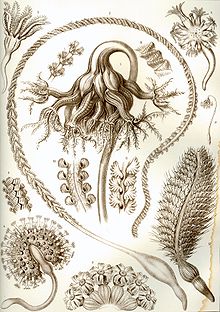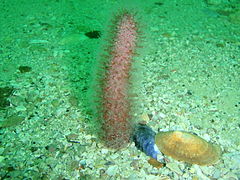Sea pen
This article needs additional citations for verification. (November 2007) |
| Sea pen Temporal range:
| |
|---|---|

| |
| "Pennatulida" from Ernst Haeckel's Kunstformen der Natur, 1904 | |
| Scientific classification | |
| Domain: | Eukaryota |
| Kingdom: | Animalia |
| Phylum: | Cnidaria |
| Class: | Octocorallia |
| Order: | Pennatulacea Verrill, 1865 |
| Family | |
Sea pens are
Although the group is named for its supposed resemblance to antique
The earliest accepted fossils are known from the Cambrian-aged Burgess Shale (Thaumaptilon). Similar fossils from the Ediacaran may show the dawn of sea pens.[3] Precisely what these early fossils are, however, is not decided.[4]
Taxonomy
The order Pennatulacea consists of the following families:[5]
- Suborder Sessiliflorae
- Anthoptilidae
- Funiculinidae
- Kophobelemnidae
- Protoptilidae
- Pseudumbellulidae[6]
- Umbellulidae
- Veretillidae
- Suborder Subsessiliflorae
-
Actinoptilum molle (Echinoptilidae)
-
Renillidae)
-
Veretillum sp. (Veretillidae)
-
Virgularia sp. (Virgulariidae)
Biology
Due to the geographic distribution, a result of inflating themselves with seawater which causes them to get carried by the currents, there is genetic variation within the different species of sea pen. [clarification needed] There are many populations of sea pens found in mainly Indian waters. It is their polyps that are affected genetically, as they have dispersed within the different waters and islands, and how they use their polyps (tentacles) to protect themselves and other species.[7]



As
Using their root-like peduncles to anchor themselves in sandy or muddy substrate, the exposed portion of sea pens may rise up to 2 metres (6.6 ft) in some species, such as the tall sea pen (
While generally sessile animals, sea pens are able to relocate and re-anchor themselves if need be.
Like other anthozoans, sea pens reproduce by coordinating a release of sperm and eggs into the water column; this may occur seasonally or throughout the year. Fertilized eggs develop into larvae called planulae which drift freely for about a week before settling on the substrate. Mature sea pens provide shelter for other animals, such as juvenile fish. Analysis of rachis growth rings indicates sea pens may live for 100 years or more, if the rings are indeed annual in nature.
Some sea pens exhibit glide reflection symmetry,[10] rare among extant animals.
Aquarium trade
Sea pens are sometimes sold in the aquarium trade. However, they are generally hard to care for because they need a very deep substrate and have special food requirements.
References
- PMID 30471843.
- ^ PMID 21829500.
- ^ Williams, Gary C. "Aspects of the Evolutionary Biology of Pennatulacean Octocorals". Department of Invertebrate Zoology and Geology. California Academy of Sciences. Retrieved 2023-01-27.
- S2CID 83486435.
- ^ "Pennatulacea". World Register of Marine Species. Retrieved 2018-04-03.
- S2CID 248243502.
- .
- ^ ISBN 0-03-056747-5.
- JSTOR 1942312.
- ^ Zubi, Teresa (2016-01-02). "Octocorals (Stoloniferans, soft corals, sea fans, gorgonians, sea pens) - Starfish Photos - Achtstrahlige Korallen (Röhrenkorallen, Weichkorallen, Hornkoralllen, Seefedern, Fächerkorallen)". starfish.ch. Retrieved 2016-09-08.
External links
- "Photos of Sea Pens". starfish.ch.






